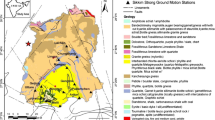Abstract
This study examines the time and frequency features of strong motion records obtained during the 12th November 2017 Mw 7.3 Ezgeleh (Iran) Earthquake. Different parameters including peak ground acceleration (PGA), peak ground velocity (PGV), spectral acceleration, significant duration, Arias intensity and Fourier amplitude are illustrated to provide a clear view on main characteristics of this event. As an important finding, a broad-band frequency content characteristic is obvious from the analysis of Fourier amplitude spectra obtained at four closest stations records. According to the results, the record obtained at Sarpol-e Zahab station could be considered as near-fault pulse-like motion. The amount of input energy and its corresponding level of frequency are discussed based on wavelet analysis. Results showed that more than 50% of earthquake energy at Sarpol-e Zahab city has been concentrated around 0.45 s which is close to the natural vibration period of low-to mid rise structures in the region. Finally, seismic intensity in terms of modified Mercalli intensity was extracted based on the Fourier spectrum amplitude and the peak ground motion parameters (PGA, PGV) in Sarpol-e Zahab city which was the worst affected area.












Similar content being viewed by others
References
Atkinson G, Kaka S (2007) Relationship between felt intensity and instrumental ground motion in the central United States and California. Bull Seismol Soc Am 97(2):497–510
Baker JW (2007) Quantitative classification of near-fault ground motions using wavelet analysis. Bull Seismol Soc Am 97:1486–1501
Berberian M (1995) Master “blind” thrust faults hidden under Zagros folds: active basement tectonics and surface morphotectonics. Techtonophysics 89:120–139
Bommer JJ, Stafford PJ, Alarcón JA (2009) Empirical equations for the prediction of the significant, bracketed, and uniform duration of earthquake ground motion. Bull Seismol Soc Am 99(6):3217–3323
Bray JD, Rodriguez-Marek A (2004) Characterization of forward directivity ground motions in the near-fault region. Soil Dyn Earthq Eng 24:815–828
Chang Z, Sun X, Zhai C, Zhao JX, Xie L (2017) An improved energy-based approach for selecting pulse-like ground motions. Earthquake Eng Struct Dynam 45(3):757–771
Iran Strong Motion Network, Building & Housing Research Center (BHRC)
Irikura K, Kamaei K (1994) Estimation of strong ground motion in broad-frequency band based on a seismic source scaling model and an empirical Green’s function technique. Ann Geofis 37:1721–1743
Irikura K, Miyake H (2011) Recipe for predicting strong ground motion from crustal earthquake scenarios. Pure appl Geophys 168:85–104
Minimum Design Loads for Buildings and Other Structures (ASCE 7-10) (2010) American Society of Civil Engineers, Reston, Virginia
Nakamura Y (1989) A method for dynamic characteristics estimation of subsurface using micro-tremor on the ground surface. Quarterly report of RTRI 30, pp 25–33, Railway Technical Research Institute, Tokyo, Japan
Nissen E, Tatar M, Jackson JA, Allen MB (2011) New view on earthquake faulting in Zagros fold-and-thrust belt of Iran. Geophys J Int 186(3):928–944
Preliminary report on 12th November 2017, magnitude 7.3 earthquake in Sarpol-e Zahab, Kermanshah Province, 3rd Edition, November 2017, International Institute of Earthquake Engineering and Seismology (IIEES), Tehran, Iran (in Persian)
Rupakhety R, Sigurdsson SU, Papageorgiou AS, Sigbjörnsson R (2011) Quantification of ground-motion parameters and response spectra in the near-fault region. Bull Earthq Eng 9(4):893–930
Sokolov V (2002) Seismic intensity and Fourier acceleration spectra: revised relationship. Earthq Spectra 18:161–187
Somerville PG, Smith NF, Graves RW, Abrahamson NA (1997) Modification of empirical strong ground motion attenuation relations to include the amplitude and duration effects of rupture directivity. Seismol Res Lett 68:199–222
Standard No. 2800 (2014) Iranian code of practice for seismic resistant design of buildings, 3. Building & Housing Research Center, Iran (in Persian)
Tselentis G-A, Danciu L (2008) Empirical relationships between modified Mercalli intensity and engineering ground-motion parameters in Greece. Bull Seismol Soc Am 98(4):1863–1875
Yaghmaei-Sabegh S (2013) Analysis of applicability of seismic intensity estimation using Fourier spectrum of ground motions for Iranian earthquakes. Pure appl Geophys 170:597–606
Yaghmaei-Sabegh S (2014) Time–frequency analysis of the 2012 double earthquakes records in North-West of Iran. Bull Earthq Eng 12:585–606
Yaghmaei-Sabegh S, Tsang H-H (2014) Site class mapping based on earthquake ground motion data recorded by regional seismographic network. Nat Hazards 73:2067–2087
Yaghmaei-Sabegh S, Tsang H-H, Lam NTK (2011) Conversion between peak ground motion parameters and modified Mercalli intensity values. J Earthquake Eng 15:1138–1155
Yaghmaei-Sabegh S, Shoghian Z, Sheikh MN (2014) A new model for the prediction of earthquake ground motion duration in Iran. Nat Hazards 70(1):69–92
Zhai C, Cahng Z, Li SH, Chen Z, Xie L (2013) Quantification of near-fault pulse-like ground motion based on energy. Bull Earthq Eng 103(5):2591–2603
Acknowledgement
The authors gratefully acknowledge the contributions by Building and Housing Research Center (BHRC) for providing the strong-motion records used in this study. The author gratefully acknowledges the contributions by Dr. M.P Shahvar who facilitate data preparation from BHRC. The authors are grateful to the authoritative reviewers and Dr. John Douglas whose comments significantly improved quality of this study.
Author information
Authors and Affiliations
Corresponding author
Rights and permissions
About this article
Cite this article
Yaghmaei-Sabegh, S. Interpretations of ground motion records from the 2017 Mw 7.3 Ezgeleh earthquake in Iran. Bull Earthquake Eng 17, 55–71 (2019). https://doi.org/10.1007/s10518-018-0453-2
Received:
Accepted:
Published:
Issue Date:
DOI: https://doi.org/10.1007/s10518-018-0453-2



